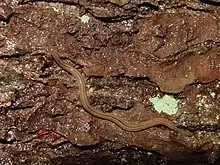Bipalium pennsylvanicum
Bipalium pennsylvanicum, the three-lined land planarian, is a species of land planarian in the subfamily Bipaliinae.[1][2] They are native to Asia, but found mostly in Pennsylvania and the surrounding areas.[3][2] They can reach a length of 5.1 inches (130 mm) or more, with a diet consisting mostly of earthworms. They reproduce sexually by creating a cocoon in the spring, but unlike related planarians, they cannot reproduce through binary fission.[2] It is not recommended to touch these flatworms without gloves, because their mucous contains a toxin that is used for digesting prey and can cause skin irritation for some people.[4]
| Bipalium pennsylvanicum | |
|---|---|
 | |
| Scientific classification | |
| Domain: | Eukaryota |
| Kingdom: | Animalia |
| Phylum: | Platyhelminthes |
| Order: | Tricladida |
| Family: | Geoplanidae |
| Genus: | Bipalium |
| Species: | B. pennsylvanicum |
| Binomial name | |
| Bipalium pennsylvanicum Ogren, 1987 | |
References
- Ogren, Robert E (1987). "Description of a New Three-Lined Land Planarian of the Genus Bipalium (Turbellaria: Tricladida) from Pennsylvania, U.S.A". Transactions of the American Microscopical Society. 106 (1): 21–30. doi:10.2307/3226281. JSTOR 3226281.
- "Hammerhead Flatworms and Other Land Planaria of Eastern North America". Penn State Extension. May 2, 2022. Retrieved July 20, 2022.
- Barker, G.M. (2004). Natural Enemies of Terrestrial Molluscs. Oxfordshire: CABI Publishing. pp. 242–248. ISBN 0851993192. Retrieved July 30, 2022.
- Draper, Erik (May 27, 2022). "Hammerhead Hysteria". Buckeye Yard and Garden onLine. Ohio State University. Retrieved July 30, 2022.
Further reading
This article is issued from Wikipedia. The text is licensed under Creative Commons - Attribution - Sharealike. Additional terms may apply for the media files.